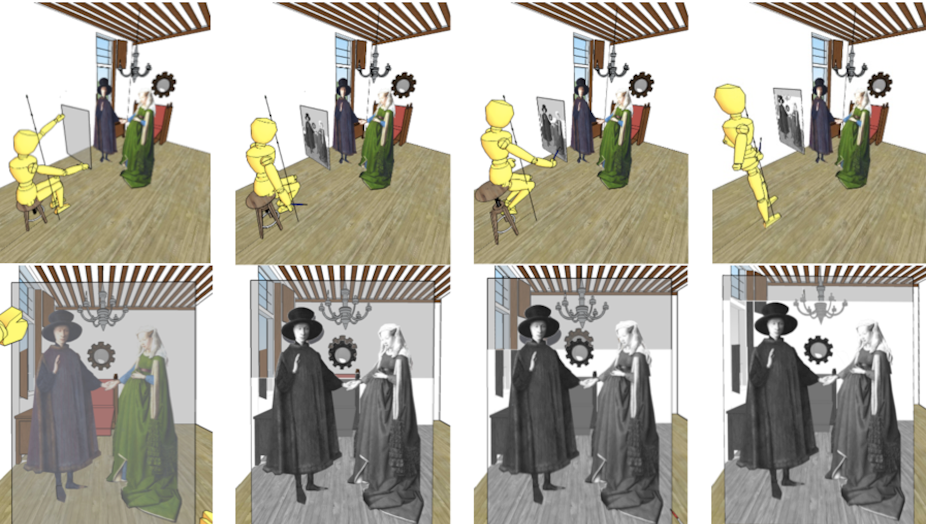For centuries, the work of Flemish painter Jan van Eyck (c. 1390-1441) has perplexed art historians. Van Eyck is famed for his empirical use of perspective, yet many have struggled to find geometrical coherence in his representation of space.
In one of his most celebrated works, the Arnolfini Portrait, which depicts a wealthy, Italian married couple, it is seemingly impossible to find a single vanishing point – the spot furthest from the viewer, at which all of the parallel lines in a painting meet.
In 1905, mathematician Karl Doehlemann demonstrated in a journal article that the parallel lines in the Arnolfini Portrait do not converge toward a single point, but rather toward a circular zone of many vanishing points. The Doehlemann interpretation is still widely accepted today, but a handful of art historians have continued to search for a hidden order behind the painting’s apparent disorder.
Since the early 1990s, researchers have used computer analysis to try to understand the use of perspective in the painting. But the Arnolfini Portrait continues to present difficulties to those who try to analyse it with algorithms.
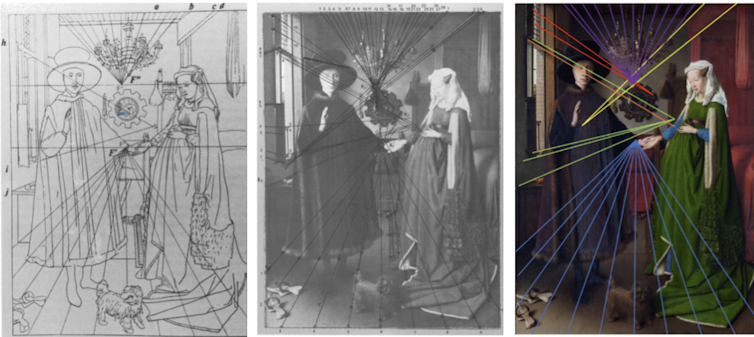
Designed primarily for processing photographs, current algorithms do not take certain important factors into account, namely the fact that there are often fewer parallel lines in a painting than in a photograph. As such, computer vision specialists do not typically use paintings as test subjects.
Finding van Eyck’s vanishing points
Our new research into van Eyck’s work takes into account the inherent uncertainty in the accepted understanding of parallel lines and posits an a contrario reasoning.
A well-known concept in computer vision, a contrario methods rely on a psychological concept known as the Helmholtz principle, which states that “we perceive immediately what cannot be due to chance” or, reinterpreted mathematically, “our algorithm will detect what cannot be due to chance”.
When the Helmholtz principle is applied to a probability map of the vanishing points in the Arnolfini Portrait, a surprisingly ordered structure appears, comprising four main points aligned periodically along a slightly inclined vertical axis.
Similar structures are found in the painter’s other works, such as Saint Jerome in His Study, the Lucca Madonna, the Dresden Triptych and Madonna in the Church.
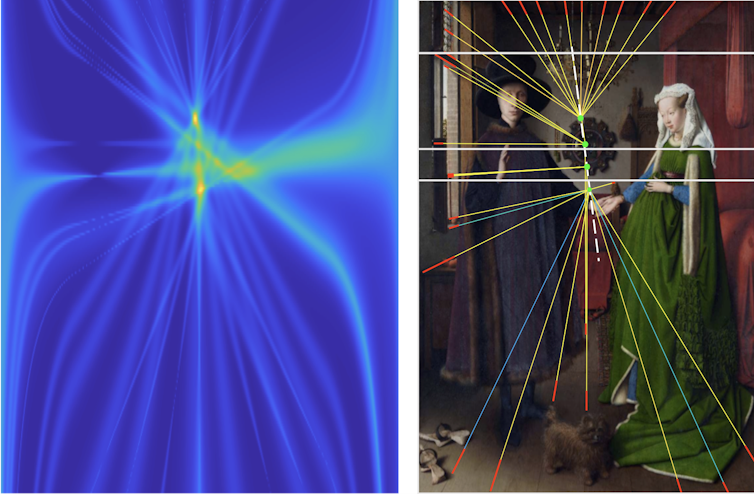
Each of these works may be partitioned into several horizontal strips equal to the number of vanishing points, with each strip containing all the edges associated with one particular point.
When the painting is split into parts, we can see that van Eyck’s perspectives were far from disordered. In fact, they were rigorously exact.
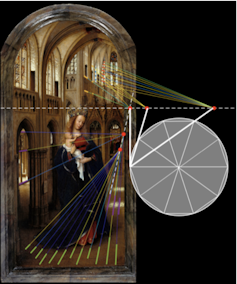
The case of Madonna in the Church is particularly interesting. Measuring just 14 x 31 cm, this quasi-miniature painting makes use of extremely precise converging lines.
More surprisingly still, the positions of the vanishing points found in the upper strip of the painting are in perfect coherence with the half-decagon geometry of a church choir gallery. This was an unexpected finding, as no one at the time could have known how to place a vanishing point on the horizon line according to its direction in three-dimensional space.
Our argument based on this finding is that van Eyck used an optical device to produce his works.
A perspective machine
Almost half a century after van Eyck’s death, Leonardo da Vinci sketched a simplified version of what is called a “perspective machine”.
Da Vinci’s sketch depicts the artist drawing out the visible objects using a pane of glass, while gazing through an eyepiece.
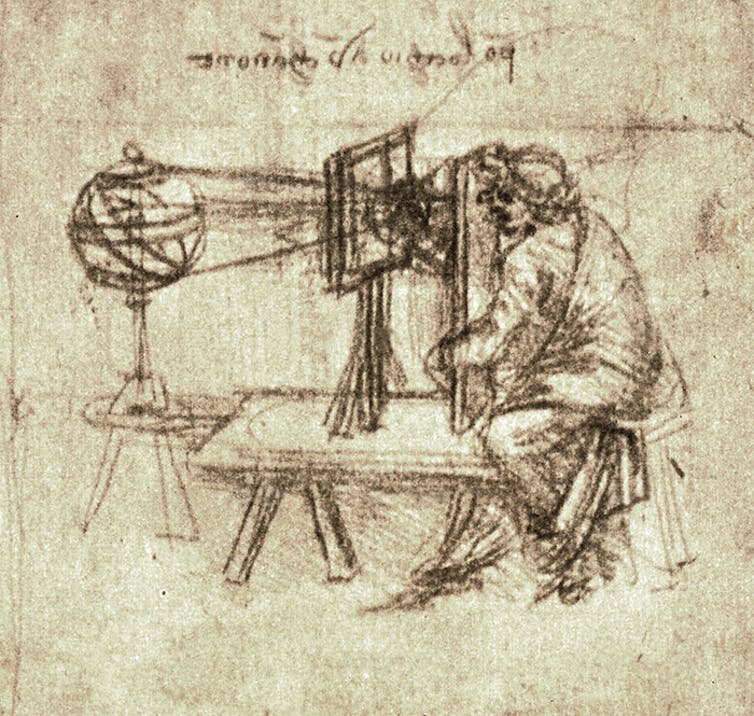
Van Eyck’s device would have been more elaborate, with several eyepieces equally spaced out along an inclined axis, just like the vanishing points in the Arnolfini Portrait. Using it, he could have outlined parts of reality strip by strip (eyepiece by eyepiece) with a carbon ink that he then transferred to a primed wood panel before painting it.
The glass pane – probably a mirror – could itself be moved within its plane such that the edge of the previously drawn image strip could be joined to the actual image as seen through the eyepiece.
This crucial step enabled the painter to produce smooth transitions between the strips, which would have been difficult to perceive with the naked eye alone. In the video below, we have illustrated how this might have worked in practice.
Painting reality as we perceive it
Our reconstruction of the painting of the Arnolfini Portrait lets us see what van Eyck would have seen through the eyepieces; for instance, the rise in the ceiling between the view from below and the view from above, which was the one he finally chose (and vice versa for the floor), perhaps to avoid distortion around the painting’s edges.
From an optics viewpoint, amplified perspective distortions on the edges of a painting are not technically incorrect, but we are unaccustomed to them. This is because the visual field of the human eye is more restricted compared to what can be achieved in a short-distance artificial perspective or, perhaps, through a glass pane.
For the Arnolfini Portrait, our analysis suggests that the horizontal distance between the eyepieces placed at each end of the view axis was the same as the distance between the pupils of an adult man.
It is up to individuals to decide whether this was a coincidence, but I would wager that it was not. I imagine that van Eyck would have alternately closed his left and right eyes, observing how this action affected the perception of his own hand and deciding then to equip his device with both viewing options.
Focusing on the important aspects
With regard to the Arnolfini Portrait, researchers have underlined the importance of properly representing hands and feet in this era, both in terms of symbolism and aesthetics. Although most of the objects in the painting were drawn only once through the perspective of the eyepiece placed farthest forward, our models suggest the male figure’s feet and raised hand were drawn using other eyepieces.
Given that the painting was divided into strips of varying thickness, one might suggest that van Eyck focused his attention on four zones of interest: the ceiling, the male figure’s head and hat, his raised hand, and his lower body. It would seem that he placed particular care on producing the patron’s portrait, perhaps even more so than the surrounding architecture.
Van Eyck’s polyscopic (multi-lensed) device could well have evolved from an earlier monoscopic one, like the device drawn by da Vinci. This may have coincided with the need to produce a full-length portrait of Adam on his masterpiece, the Ghent Altarpiece, following his earlier completion of several head-and-shoulders portraits.
Translated from the French by Enda Boorman for Fast ForWord


